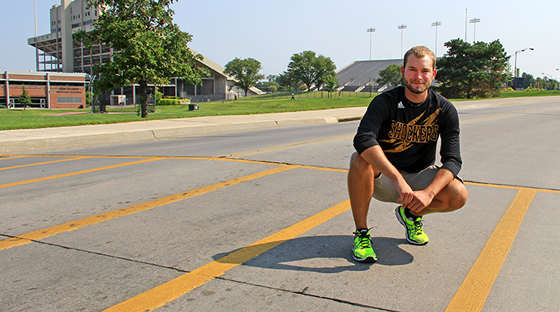The dangers of texting and driving have become the focal point of driving research in recent years, but Wichita State University graduate student Colton Turner is taking his research one step further and looking at the dangers faced by pedestrians.
According to the National Highway Traffic Safety Administration, nearly 76,000 pedestrians were injured in traffic accidents in 2012. With those stats in mind, Turner and a group of WSU faculty and students have sought to find out what is causing so many accidents.
They did this by placing volunteer participants in the passenger seat of a vehicle driven at night on a closed course at Kansas Law Enforcement Training Center in Hutchinson. The passengers were instructed to act as if they were driving – push a GPS recorder when they saw a pedestrian, pay attention to hazards and report road signs they saw – all while periodically responding to text messages.
The pedestrians were outfitted in various clothes – black, gray or wearing what the researchers call “bio motion” – clothing highlighted with reflective strips strategically placed at the ankles, knees, waist, chest, shoulders, elbows and wrists.
Pedestrians were detected up to eight times farther away when wearing strategically placed reflective gear than when wearing all black, and five times farther away than when wearing all gray.
Whether the passenger was texting made no difference to the results.
Turner says they expected to find that texting was the biggest danger to pedestrians. And while texting is still unequivocally a huge hazard, the group was surprised to discover that at night, what a pedestrian is wearing is more important than what the driver is doing.
Turner says these findings go against most literature about distracted driving.
“This research is important because it is helping us to understand how distraction affects a driver’s ability to detect pedestrians at night, while simultaneously exploring how pedestrian clothing type affects a driver’s ability to detect them,” he says. “We have something really unique and special here with application to the real world.”
An effective solution
This ongoing study has been a large undertaking involving many collaborators, including Alex Chaparro, Jibo He, Joseph Crandall and Jake Ellis from the psychology department; students Leo Kust, David Libby and Maria Chaparro; and Richard Tyrrell from Clemson University.
This past April, the project – which started two years ago with a $1,000 WSU Undergraduate Research Grant – won the oral presentations portion of the Undergraduate Research and Creative Activity Forum.
The next step for the research project is to have participants driving the car with full control and doing the same tasks as before.
“(We) will explore how texting affects a driver’s ability to detect pedestrians when the driver has full control of the vehicle,” says Chaparro.
Beyond that, Turner says they plan to test different types of clothing configurations to find what is safest for not only pedestrians, but for road workers and emergency personnel such as police, fire fighters and EMTs.
He says bio motion, specifically, is the best option for keeping pedestrians safe, adding that anyone who plans to be roadside at night needs this type of clothing.
“We already see instances of clothing companies incorporating varying amounts of reflective markings into running clothes, but in most instances these reflective markings are small and meaningless,” he says. “What makes bio motion so effective is its ability to illuminate the form of a human body under the presence of light at night. Humans are incredibly good at identifying human form, and that is why bio motion is so effective.”


 Tim Hart
Tim Hart